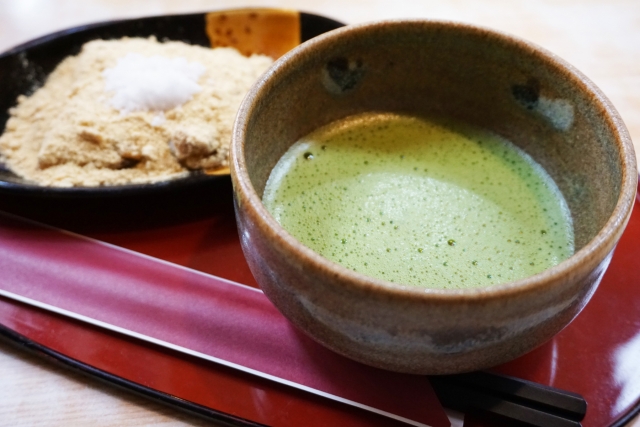Matcha is a powdered green tea. Since olden times, it has most commonly been prepared and served in the form of tea ceremonies.
Contents:
- What is Matcha (Green Powdered Tea)?
- The History of Tea
- Cultivation of Tea
- Matcha tea benefits
- Recipes with matcha green tea powder
- Matcha Soy Milk Dessert Recipe
- Smooth Matcha Pudding Recipe
- Matcha Ice-cream Recipe
- Easy-to-make Matcha Kinak Shake Recipe
What is Matcha (Green Powdered Tea)?
 Like the saying, “nichijousahanji,” which means everyday occurrence includes the kanji for tea “cha” and rice “han”, tea has been a most vital and irreplaceable part of our daily lives since ancient times. Tea is known as an aromatic beverage, generally prepared and enjoyed through the combination of tea leaves with hot water. Recently, however, the flavors of tea have also been savored and enjoyed through various foods. And matcha is no doubt the leading trendsetter of such new innovations. Matcha is a powdered green tea. Since olden times, it has most commonly been prepared and served in the form of tea ceremonies. However, matcha’s adaptability and variability prove limitless. Not only do you find it being used in traditional Japanese confectioneries, but western desserts such as cakes, and cookies are also increasingly being made matcha-flavored. Matcha salt has even been invented as a new condiment for tempura! Perhaps such trends are the result of our new recognition for tea, not only as a beverage, but also as a flavor to be savored. So what kind of tea is matcha? Let’s first begin our journey into exploring the vast world of matcha with an introduction to the history and evolution of tea.
Like the saying, “nichijousahanji,” which means everyday occurrence includes the kanji for tea “cha” and rice “han”, tea has been a most vital and irreplaceable part of our daily lives since ancient times. Tea is known as an aromatic beverage, generally prepared and enjoyed through the combination of tea leaves with hot water. Recently, however, the flavors of tea have also been savored and enjoyed through various foods. And matcha is no doubt the leading trendsetter of such new innovations. Matcha is a powdered green tea. Since olden times, it has most commonly been prepared and served in the form of tea ceremonies. However, matcha’s adaptability and variability prove limitless. Not only do you find it being used in traditional Japanese confectioneries, but western desserts such as cakes, and cookies are also increasingly being made matcha-flavored. Matcha salt has even been invented as a new condiment for tempura! Perhaps such trends are the result of our new recognition for tea, not only as a beverage, but also as a flavor to be savored. So what kind of tea is matcha? Let’s first begin our journey into exploring the vast world of matcha with an introduction to the history and evolution of tea.
The History of Tea
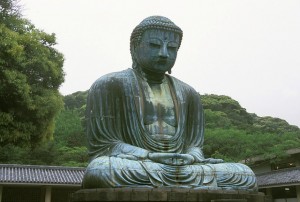 Tea originated in China over 5000 years ago as a panacea. Back then, tea was a kind of herbal medicine consumed on a regular basis by people of the elite class. Tea was introduced to Japan during the beginning of the Heian period (794-1185). Ancient recordings indicate that the first tea seeds were brought back from the Tang-dynasty by priests named Saicho, and Kukai. At that time, tea was extremely valuable and considered a luxury item that was only available to priests and nobles.
Tea originated in China over 5000 years ago as a panacea. Back then, tea was a kind of herbal medicine consumed on a regular basis by people of the elite class. Tea was introduced to Japan during the beginning of the Heian period (794-1185). Ancient recordings indicate that the first tea seeds were brought back from the Tang-dynasty by priests named Saicho, and Kukai. At that time, tea was extremely valuable and considered a luxury item that was only available to priests and nobles.
The founding techniques to prepare tea were introduced to Japan during the Kamakura period. Generally, Japanese tea ceremonies (chanoyu) refer to the act of preparing tea for guests, and a variety of different tea ceremony activities, such as tea competition parties and tea kabuki, permeated the warrior class. In contrast to such trends, Sen no Rikyu created a new method of serving tea, known as wabi-cha, which emphasized the importance of spiritual exchanges with the guest during the tea ceremony, and led to the full development of today’s chado, or “the way of tea”.
Cultivation of Tea
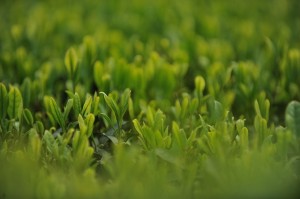 The most common green tea in Japan, sencha, is made from leaves that are exposed directly to sunlight. However, the highest grade Japanese green tea, gyokuro, is cultivated in a special way with leaves that are grown in the shade before harvest. In this type of cultivation, tea plantations are covered with straw racks to shield the tea plants from direct exposure to sunlight. This allows for tea leaves to accumulate plenty of nutrition, and increase more amino acids (theanine), which produces a distinct aroma, and a rich, delicious, and sweet flavor. This method of cultivation is also used in producing tencha. Tencha is made by removing the stems and veins from the dried tealeaves. Matcha is the fine powder made from grinding tencha tea leaves. In this way, matcha is cultivated in the same way as the highest-grade tea, gyokuro and is therefore known to be one of Japan’s high-grade teas.
The most common green tea in Japan, sencha, is made from leaves that are exposed directly to sunlight. However, the highest grade Japanese green tea, gyokuro, is cultivated in a special way with leaves that are grown in the shade before harvest. In this type of cultivation, tea plantations are covered with straw racks to shield the tea plants from direct exposure to sunlight. This allows for tea leaves to accumulate plenty of nutrition, and increase more amino acids (theanine), which produces a distinct aroma, and a rich, delicious, and sweet flavor. This method of cultivation is also used in producing tencha. Tencha is made by removing the stems and veins from the dried tealeaves. Matcha is the fine powder made from grinding tencha tea leaves. In this way, matcha is cultivated in the same way as the highest-grade tea, gyokuro and is therefore known to be one of Japan’s high-grade teas.
During the time matcha was introduced to Japan, tencha tea leaves were ground in the same instrument used to mix a medicine known as “ten”, which is the reason for its given name. The method of grinding matcha using a stone mill began during the middle of the Kamakura period; however, even today, this method is still used at matcha factories around Japan. No matter how much modernization continues to advance, the fundamental techniques and tools used to make green tea will never change. This is how Japan’s priceless traditional flavor and quality of tea are kept preserved.
Matcha tea benefits
 Matcha has the most distinctive flavor that’s astringent and bitter, yet sweet. However, it is also rich in many nutrients including vitamin C, vitamin E, folic acid, and fiber, and is known for its many health benefits. Adequate vitamin intake is essential for the functions of our body. By simply incorporating tea into your daily diet, your body will be supplied and nourished with all of the necessary vitamins. Furthermore, vitamin E does not dissolve in water, so it’s intake through matcha tea leaves are especially effective. The sweetening component in matcha, theanine, has also been shown to stimulate the nervous system and send signals to the brain to produce alpha waves and secrete dopamine. Therefore, it will help you feel calm and relaxed. In this way, matcha gently heals the mind, the body, and the soul, and continues to play a significant role as a part of the Japanese diet and culture.
Matcha has the most distinctive flavor that’s astringent and bitter, yet sweet. However, it is also rich in many nutrients including vitamin C, vitamin E, folic acid, and fiber, and is known for its many health benefits. Adequate vitamin intake is essential for the functions of our body. By simply incorporating tea into your daily diet, your body will be supplied and nourished with all of the necessary vitamins. Furthermore, vitamin E does not dissolve in water, so it’s intake through matcha tea leaves are especially effective. The sweetening component in matcha, theanine, has also been shown to stimulate the nervous system and send signals to the brain to produce alpha waves and secrete dopamine. Therefore, it will help you feel calm and relaxed. In this way, matcha gently heals the mind, the body, and the soul, and continues to play a significant role as a part of the Japanese diet and culture.
Recipes with matcha green tea powder
Let’s Taste the Flavors of Matcha
The following recipes are modern arrangements of traditional Japanese tastes. Indulge in the pleasures of cold matcha sweets that are perfect for the summer season!
Matcha Soy Milk Dessert Recipe
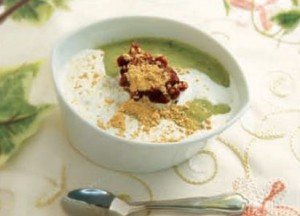
Ingredients (Serves 4)
- 1 Tbsp. matcha
- 4 Tbsp. boiling water
- 5g (0.8oz) powdered gelatin
- 3 Tbsp. water
- 60g (2.17oz) granulated sugar
- 200ml (0.85cups) soymilk
- 100ml (0.42cups) milk
- 2 Tbsp. whipped cream
- 1 small can boiled azuki beans
- 1 Tbsp. kinako
Cooking Directions
- Soak the powdered gelatin in water. Dissolve the matcha completely in boiling water. If it’s difficult to dissolve, pour it once through a tea strainer.
- Heat milk and granulated sugar in a pot, and simmer to dissolve. Once sugar dissolves, turn the heat off, add the dissolved green tea and mix together well. Next, add the soaked gelatin and dissolve with the remaining heat.
- Add soy milk into the mixture and stir together. Place the bottom of the pot into ice water, and mix until it thickens. Pour into cups or trays, and let it cool in the refrigerator for at least 30 minutes.
- Top it with boiled azuki beans, whipped cream, and kinako, before serving.
Smooth Matcha Pudding Recipe
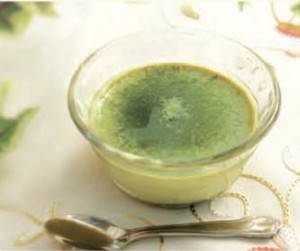
Ingredients (Serves 4)
- 400ml (1.7cups) + 150ml (0.63 cups) milk
- 2 egg yolks
- 1 whole egg
- 90g (3.17 oz) granulated sugar
- 10g (0.35 oz) matcha
Cooking Directions
- Beat egg yolks in a bowl. Add the granulated sugar and mix well. Set aside (keep the top covered with a wrap so it doesn’t dry out)
- Add milk into a single-handled pot and heat on medium-heat until the rims begin to fizzle.
- Turn the heat off. Stir and dissolve the matcha into a small amount of the boiled milk. Then mix in the rest of the milk.
- Pour the mixture from step 3 through a strainer. Add the remaining 150ml of milk.
- Mix together 1. and 4. Pour it through a strainer again. (straining it twice is the key)
- Pour the mixture into cups and tightly cover the tops with aluminum foil.
- Before the mixture cools down, place the cups into a pot. The pot should be filled with water to about half the height of the cups. Steam for 10 minutes and then remove the aluminum foil. If the center looks settled, it’s done.
- First let it steam off and cool down in room temperature. Then refrigerate for 3 hours.
Matcha Ice-cream Recipe
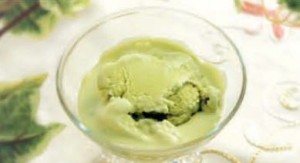
Ingredients (Serves 6)
- 200ml (0.85 cups) vegetable fat whipping cream
- 2 egg yolks
- 5 Tbsp. sugar
- 50ml (0.21 cups) water
- 1 Tbsp. matcha
- 2 Tbsp. boiling water
Cooking Directions
- Beat whipping cream until it forms stiff peaks.
- Heat sugar and water in a pot, and simmer to dissolve.
- Beat egg yolk in a bowl, slowly add mixture from step 2. and beat until it thickens. After dissolving the matcha in water, add it into the mixture.
- Add mixture from step 1. to mixture from step 3, mix together well, and pour it into a container. Put it in the refrigerator. In the middle of refrigerating, mix it 2 to 3 more times. Then allow it to cool and harden.
Easy-to-make Matcha Kinako Shake Recipe
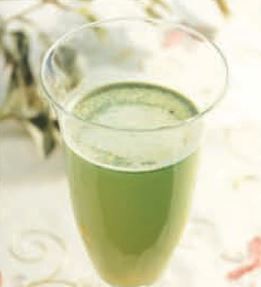
Ingredients (Serves 4)
- 1 1/2 tsp. matcha
- 4 Tbsp. kinako
- 1 1/2 Tbsp. kibi sugar
- 400ml (1.7 cups) milk
Cooking Directions
Add all the ingredients into an airtight container such as a plastic bottle. Shake it to blend and mix well.
